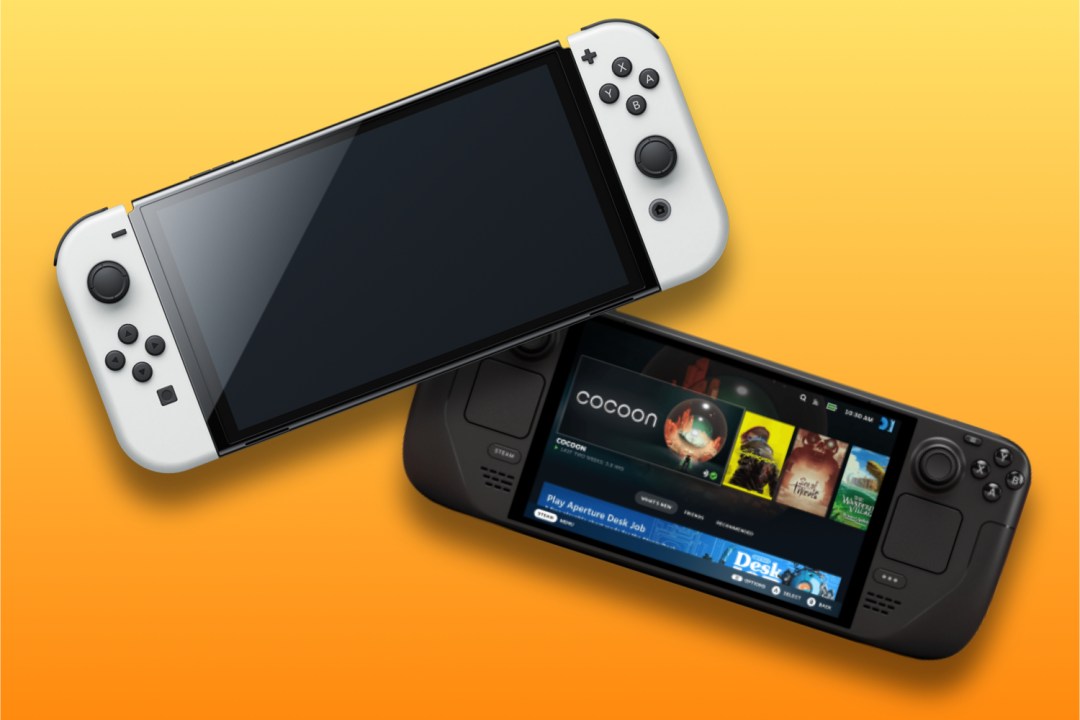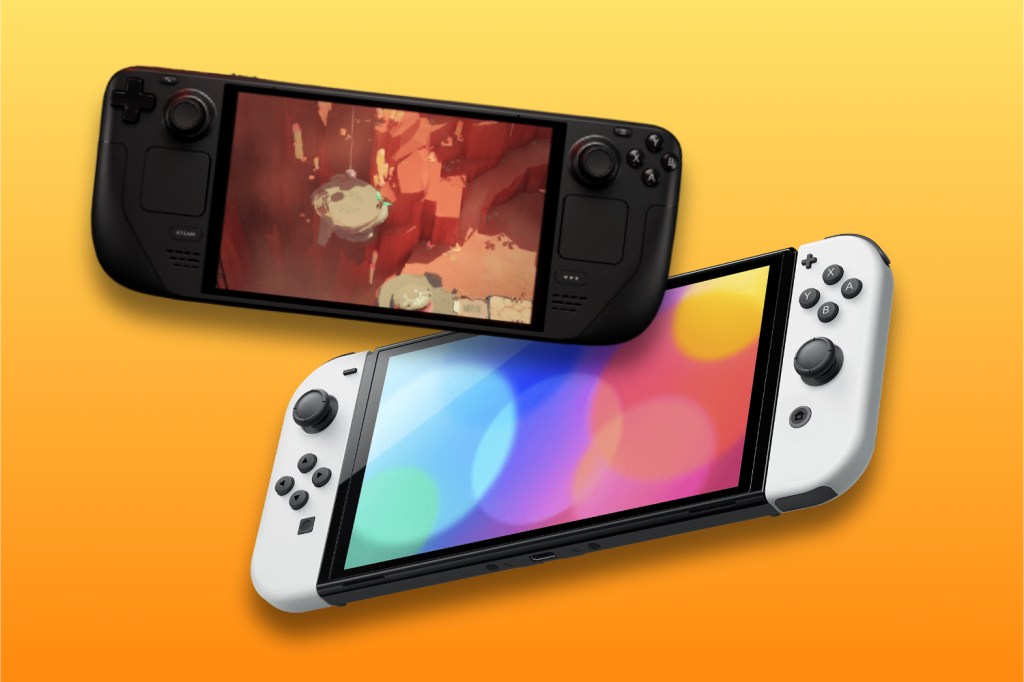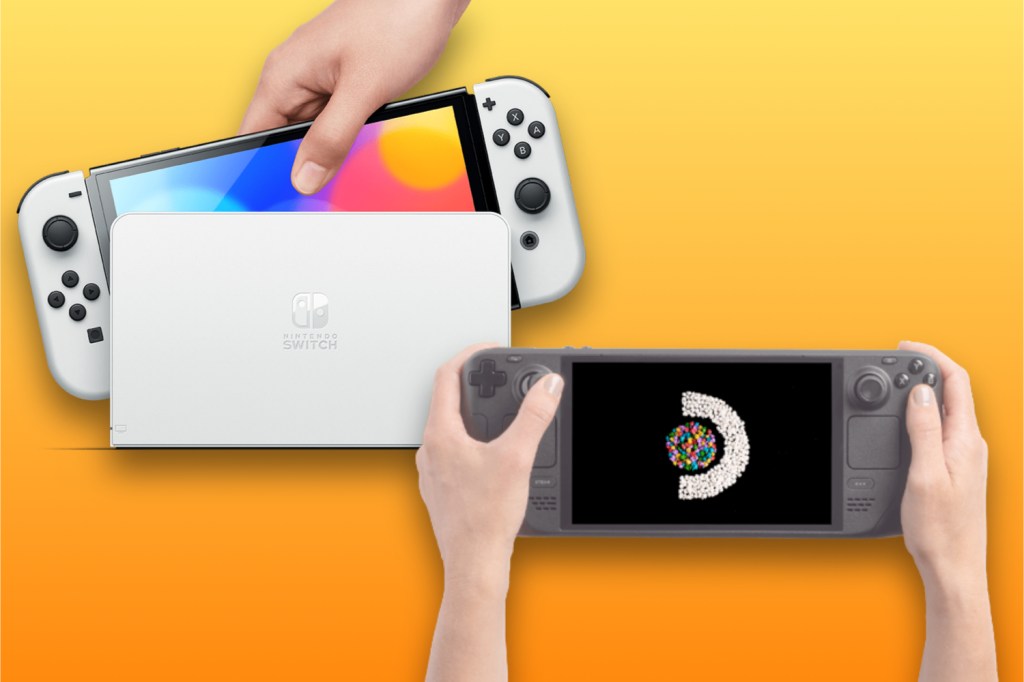Steam Deck OLED vs Nintendo Switch OLED: the two handhelds compared
It's new kid on the block vs the fan favourite in this comparison of the two handheld consoles.

The handheld console has taken the gaming world by storm, offering a more convenient console that you can take on the go. The latest to hit the scene is the Steam Deck OLED – a more premium version of the Steam Deck. It follows in the footsteps of Nintendo, who made a similar move with the Switch.
So it makes perfect sense that we pit the two consoles head-to-head. We’re diving into the nitty-gritty of two of the most talked-about handheld gaming devices on the market: the Steam Deck OLED and the Nintendo Switch OLED. Which is the better console to pick?
Design: brain vs brawn

Let’s start with design, because who doesn’t love a bit of tech eye-candy? The Steam Deck OLED is like the burly cousin who’s been hitting the gym. Measuring a solid 298mmx117mmx49mm and tipping the scales at about 640g, it’s not something you’d call dainty. It’s got the rugged charm of a device that means serious business, with a build quality that screams, “I can handle your gaming marathons”. The weight wasn’t a major problem for us when we reviewed the original Steam Deck. Bear in mind that hand fatigue is definitely real after a few hours.
On the flip side, the Nintendo Switch OLED is more like the ballet dancer of the duo. Sleek, elegant, and compact – it’s designed for grace and portability. Standing at a svelte 4-inches high, 9.5-inches long, and 0.55-inches deep with Joy-Con attached, and weighing in at about 322g (444g with Joy-Con), it’s the gadget you’d want to take on a posh night out. The Switch OLED balances aesthetics and practicality, making it as much a fashion statement as a gaming console.
OLED screen & battery: big or bigger?

The Steam Deck OLED dazzles with its 7.4-inch touchscreen. This screen isn’t just big; it’s bright too, offering HDR support and a 1280×800 resolution that can reach up to a retina-scorching 1000 nits. The Nintendo Switch OLED, with its 7-inch screen, doesn’t fall far behind, offering those famously vivid colours and crisp contrasts. It’s like choosing between a luxury home cinema and a top-notch TV setup.
In terms of staying power and staying connected, the Steam Deck trumps with its promise of 3 to 12 hours of gameplay courtesy of a 50Whr battery, while the Switch OLED keeps its cards close to its chest regarding battery life. When reviewing the OLED Switch, we found it inconsistently ranging between 4.5 and 9 hours. The Switch also features Wi-Fi and a wired LAN port in its dock for stable online shenanigans, while the Steam Deck flexes with tri-band Wi-Fi 6E and Bluetooth 5.3, ready to connect with just about anything.
Features & performance: racer vs family carrier

The Steam Deck OLED is a beast under the bonnet. It packs a 6nm AMD processor, Zen 2 CPU, and an AMD RDNA 2 GPU. This is the gaming equivalent of a sports car engine packed into a family carrier. The Nintendo Switch OLED, with its custom NVIDIA Tegra processor, is more like your trusty, reliable family car – not the fastest on the block, but it’ll get you where you need to go without a fuss.
Steam says the touchscreen’s responsiveness and fidelity has been vastly improved in the Steam Deck OLED. The haptics have also been tweaked to offer higher fidelity and more consistent controls. Nintendo goes for the HD Rumble haptics, which are pretty reliable. Anyone that’s used to Nintendo consoles will recognise the familiar rumbling feeling.
Storage-wise, the Steam Deck is akin to a digital Fort Knox, offering options of 512GB or 1TB SSD, plus a high-speed microSD card slot for all your hoarding needs. The Switch OLED is more modest with 64GB of internal storage, also expandable with a microSD card, making it a bit like having a neat, compact attic to store your extra bits and bobs.
Initial verdict: Steam Deck OLED vs Nintendo Switch OLED
The Steam Deck OLED and the Nintendo Switch OLED, are opposite sides of the same gaming coin. Whether you’re after the high-octane thrill of the Steam Deck or the sleek, charming allure of the Switch, both promise to deliver hours of entertainment.
But you’ll see this reflected when it comes to splashing the cash. The Steam Deck OLED, with its heavyweight specs, comes with a price tag to match at $549/£479. The Nintendo Switch OLED, on the other hand, is a bit more gentle on the wallet at $349/£299, offering a blend of style and substance without breaking the bank.


